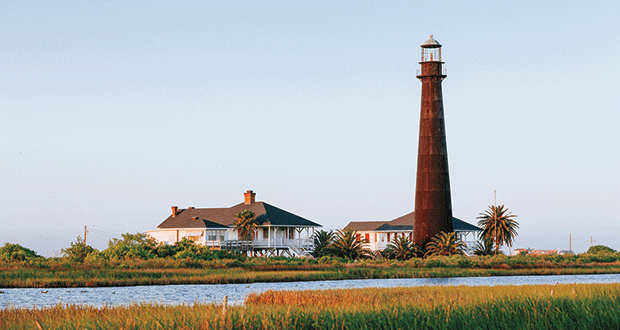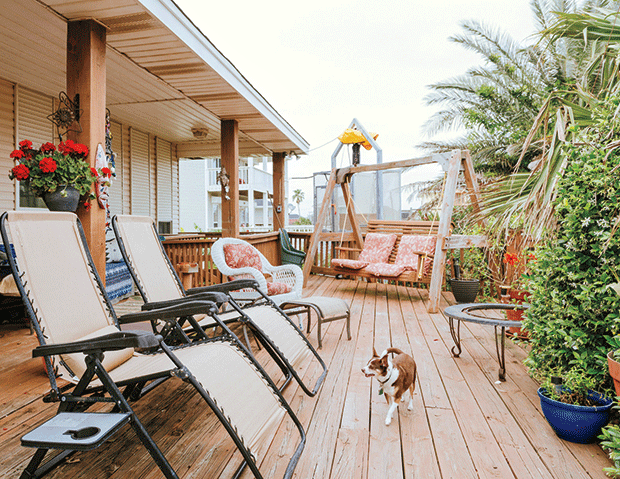 As our ferryboat approaches the landing, three dolphins suddenly surface just beyond the jetty. I declare it a positive omen, and my wife smiles. Meanwhile, cormorants and seagulls gawk from their perches atop nearby pilings. Passengers return to parked vehicles from sightseeing on deck, and the crew prepares for mooring. Behind us, where we boarded approximately three miles and 30 minutes ago, lies our home away from home, Galveston Island; ahead, a place we haven’t visited in over a decade, Bolivar Peninsula.
As our ferryboat approaches the landing, three dolphins suddenly surface just beyond the jetty. I declare it a positive omen, and my wife smiles. Meanwhile, cormorants and seagulls gawk from their perches atop nearby pilings. Passengers return to parked vehicles from sightseeing on deck, and the crew prepares for mooring. Behind us, where we boarded approximately three miles and 30 minutes ago, lies our home away from home, Galveston Island; ahead, a place we haven’t visited in over a decade, Bolivar Peninsula.
Bolivar Peninsula
For Bolivar Peninsula tourism information, call the Bolivar Peninsula Chamber of Commerce at 409/684-5940.
Soon enough, the gate rises, and we drive onto terra firma. Grateful for the lift across the channel (the free TxDOT ferry runs 24 hours a day), we continue on Texas 87, the primary artery of this 27-mile-long jut of land, bounded to the south by the Gulf of Mexico and to the north by East Galveston Bay and the Intracoastal Waterway.
Because this stretch is also called the Jane Long Memorial Highway, I think of the settler known as “the Mother of Texas,” who endured heroically in a small fort here in 1821 and 1822. Accompanied only by two children, the pregnant Long steadfastly awaited the return of her husband James Long, who ultimately died during a failed attempt to liberate Texas from Spain. Jane Long held off hostile Karankawa natives and starvation, giving birth to a daughter in the process. It’s a seminal Lone Star State legend—and a reminder that Bolivar Peninsula, while renowned for its miles of open beaches and rustic party atmosphere, is also rich with history.
We quickly encounter another historical landmark at Point Bolivar Lighthouse, a 117-foot-tall brick structure sheathed in cast-iron. Built by the U.S. government in 1872, the lighthouse provided a navigational beacon for Galveston Bay maritime traffic through 1933. During the hurricanes of 1900 and 1915, its interior stairwell also became a lifesaving refuge for hundreds of people. Now privately owned and flanked by two personal residences, the tower nonetheless reigns as the peninsula’s iconic landmark, particularly popular with photographers.
A short distance away, we turn into Fort Travis Seashore Park, its entrance marked by a trio of flagpoles and an obelisk. This 70-acre park, bordered by the Galveston Channel seawall, offers prime views of the ship traffic nearby, playgrounds, picnic tables, restrooms with showers (cold water only), and paved trails. But we focus on the architectural ruins that embellish the landscape of this former U.S. military installation (1898-1949). The largest, an artillery battery and bunker with 14 arched entrances, is built into a massive vegetation-topped mound near the seawall. Although closed to visitors today, the bunker provided safe haven for humans and livestock when Hurricane Carla struck in 1961.
Every place on Bolivar Peninsula seems to have a storm story, especially since Hurricane Ike devastated the area in 2008. But as we drive eastward, it’s apparent that the aftermath also triggered a major construction boom. The rebuilding is evident in the new and upgraded residential developments and gated communities, as well as the RV parks and various businesses in the retail hub of Crystal Beach, the largest of the peninsula’s five villages (including Port Bolivar, Caplen, Gilchrist, and High Island). All told, Bolivar Peninsula’s population numbers roughly 2,400 residents.
Upon arriving, we turn toward the Intracoastal Waterway and find one thing that hasn’t changed: Stingaree Restaurant & Marina still serves classic Gulf Coast seafood. Seated by a window in the casual eatery’s main room upstairs, we watch pelicans glide by and tugboats chug past as we feast. My spouse samples the Shrimp Lover’s Platter, featuring the namesake crustacean cooked six different ways. I opt for a customized Combo Platter of fried oysters, fried shrimp, and “BBQ” crab along with dirty rice. For an encore we share bread pudding before strolling, satisfied, back to our car.

Out by the Sea Bed and Breakfast’s outdoor deck.
The next morning, we venture farther east to High Island, a settlement established in the early 1800s atop a natural salt dome that rises 45 feet above sea level. The community earned its name by being the only land visible when major floods swept the peninsula. Thick with oak and hackberry trees, the area also provides crucial habitat for hundreds of migratory bird species that pass through each spring and fall. As bird expert Gary Clark later explains to me, “In a zone of coastal flats, the wooded areas atop High Island stand out to neotropical migrants that need food and rest to replenish energy before crossing the Gulf in the fall and after crossing it in the spring.” Consequently, the Houston Audubon Society maintains several bird sanctuaries here. Despite visiting out of season, we enjoy a tranquil hike along the arboreal trail at the Boy Scout Woods Sanctuary, home to viewing stands, boardwalks, a picnic shelter, and restrooms.
On the return drive, we look for roadside ponds and marshes, observing two roseate spoonbills, a great blue heron, and several egrets along the way. Such inland species live here year-round, as do numerous oceanfront birds. And in July and August, the beach is also crowded with a different class of migratory fowl. As Clark points out, “There are about 52 species of shorebirds that breed in North America, and 37 of them pass through the upper Texas coast,” making birds such as the piping plover a late-summer attraction, particularly at the Bolivar Flats Shorebird Sanctuary near Fort Travis.
Driving back, we visit a new Crystal Beach restaurant that becomes the culinary highlight of our trip. Located on the Intracoastal Waterway overlooking East Galveston Bay, Steve’s Landing is housed in a stylish building with high ceilings, beautifully finished cypress floors and walls, and hand-carved teakwood palm tree motifs decorating the interior pillars. Steve’s Landing serves delectable dishes befitting the cross-cultural heritage of its co-owners, Rahib Rahman and Davin Patel. My wife praises the artful presentation and exquisite flavors of her Shrimp Tikka, featuring Gulf shrimp sautéed in a spicy Indian marinade and served with jalapeño cheese grits. Meanwhile, I am delighted to taste the best crab cakes I’ve eaten—ever, anywhere. Practically devoid of breading, these luscious mounds of jumbo lump crabmeat come with a zesty remoulade sauce, potato salad, and a flavorful cup of gumbo. For dessert, we linger over coffee and a rich slice of Key lime pie.
Before we depart, Rahman shows us around the restaurant’s outdoor deck areas for dining or lounging, including the whimsical rope swing seats, and the patio area and bar on the ground level. “We started out in 2013 like a little gem in the middle of nowhere,” Rahman says, “but the word of mouth has been great for us.” Then in a pronouncement that sums up the general post-Ike renaissance on Bolivar Peninsula, he adds, “There are so many people building really nice houses here now; it’s a whole new day. Bolivar is changing.” It’s true, and having witnessed the transformation firsthand, we vow to return.








